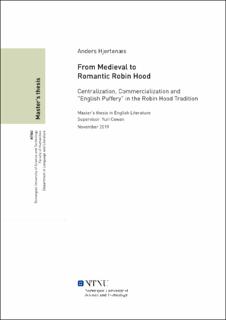| dc.description.abstract | This project argues that social developments manifested themselves differently in the literature of Robin Hood during the medieval, the early modern, and the romantic era, conveying three very different versions of resistance against oppression. Specifically, this thesis explores how Robin Hood responds to different variants of social development: centralization of outlying regions in the medieval era, commercialization of the ballad tradition in the seventeenth century, and the emergence of “English puffery” in the nineteenth century Romantic era. Framed by realist theory and new historicism, and responding to Stephen Knight’s claim that the Robin Hood legend serves as a guide to society’s “changing patterns”, the central argument of this thesis is that Robin’s enduring proverbial truth, that he robbed the rich to help the poor, is insufficient in order to explain his relevance as a symbol against oppression regardless of era. Therefore, this thesis seeks to deflate the idea that Robin was just a simple outlaw and socialist robber, and show that his enduring proverbial truth is much more complex. He is a symbol of a more general resistance against unfair change, whatever shape or form it arrives in, and that he is always prepared to rally against oppression and the misuse of power, wherever and whenever it occurs. | |
